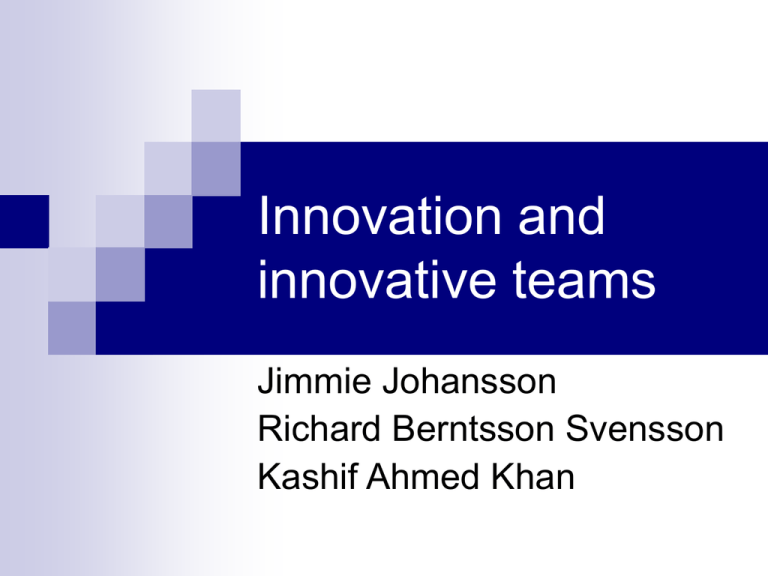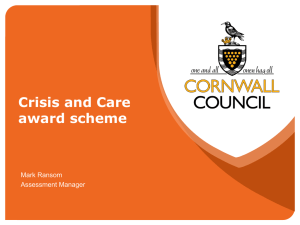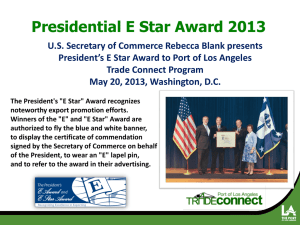Innovation and innovative teams
advertisement

Innovation and innovative teams Jimmie Johansson Richard Berntsson Svensson Kashif Ahmed Khan Agenda Creativity and Innovation The innovators Team structure Managing innovative teams The innovative team environment Rewards and recognition The management team Creativity and innovation What is Creativity? New ideas What does it mean to be Innovative? Transforming ideas into action Containing processes like: research, development, manufacturing and marketing Innovation (1/4) Industrial innovation Portable radio Boing 727 Risks of failure IBM’s OS/2 Technical focus, not marketing needs Innovation (2/4) Knut Holt Study 23 organizations were studied “Four of the firms had made no inquiries to potential users, six had made too few inquiries, two ignored the result, two had misinterpreted the answers, six were committed to preconceived designs and three failed to understand the environment to which their products would be subjected.” Innovation (3/4) The chase for the first spot Reverse engineering “There are really two risks in research and development…One is whether the technology will succeed. The other is whether it will satisfy some market requirements. If you hang back and wait, you can be in a position where you can know the answer to both questions, and catching up can take a lot less time than the original effort.” George Mechlin, Vice President for R&D in WestingHouse Innovation (4/4) Risks Is Fast pace of technology it always good to be first on the market? Maybe when turning directly to users with reverse engineering DVD - BlueRay Operating systems, network protocols and database systems. Innovators Innovator The creative person that find solution for a problem Champion Can be innovator Fights for the idea to turn into action Sponsor Makes the action happen Discussion point Is reverse engineering a good approach to successful innovation or is it more important to be first on the market? Team structure (1/3) Concepts of team structure Taylor's method Drucker Teamwork Commitment Team creativity A team performs better then the individuals alone Jelled teams increases the chance of success Team structure (2/3) Basic structure Official Individual Private Structural conflicts Interaction between the basic team structures Group ethics Unwritten team ethic Settle own disputes without outside help Team structure (3/3) Group behavior Work group Process group Combat group Managing innovative teams (1/4) Team leader style Top-down or bottom-up? “The manager’s function is not to make people work, but to make it possible for people to work” Team dynamics Closed Random Synchronous Open Managing innovative teams (2/4) Personal needs Learn members to think by themselves Political vs. technical solutions Difference between political and technical Politics often used to describe people-related work Crystallizing the team Loosely coupled individuals Managing innovative teams (3/4) Communication Communication with the manager is important Open communication Group discussion? Concerns management Involve members with right knowledge and skills Honestly presented Managing innovative teams (4/4) Managing conflicts Avoid early polarization Focus on the issues Do not deal separately Intergroup conflicts Resolve issues them self Bring parties together Subcommittee Reduce stakes Agreed technical solution Discussion points Is group ethic important? Should teams settle their own disputes? What is the manager’s function? “The manager’s function is not to make people work, but to make it possible for people to work” Is the communication with the manger the most important? Innovative team environment Office environment How people are organized Size of working group Problems that can affect innovative environments negative Actions for establishing or maintaining innovative environments (1/2) Establish program for further develop promising people Provide time and resources to good innovators Provide promising innovators and champions with sponsors Make groups in organizations not resistant and stagnant to new ideas Actions for establishing or maintaining innovative environments (2/2) Monitor outside technical and market development Provide a good communication program to make sure manager and their workers interact Provide the professionals with modern tool, space and support Reward good work Discussion points Is a smaller organization more innovative than a larger one? Is a more open landscape better for creating new ideas and innovations than a room where you can just fit a small group? Rewards and Recognition (1/1) Fertile imagination of creative people Inadequate recognition of creative people Pelz & Andrew’s Study Comparison of people who resigned and stayed in the organization No talent recognition Both award and incentive plans can be highly effective based on the needs of the company Award Programs (1/1) Few people make difference in the failure and success of a project Manager’s know these people but rarely appreciate their work Recognition Programs Basic idea is to reward significant achievements as soon as possible. ”Golden Banana” Pin Recognition Programs (1/1) Top people’s recognition is essential Aggregate of smaller contributions can have an enormous impact Minor advance should be encouraged Letter from the boss Pat on the back Rene McPherson’s observation IBM Award Plan (1/1) Formal & Informal Awards Informal Awards Range from $50 to $ 1500 Can be given at manager’s discretion Formal Awards Divisional Management grant sums up to $25,000 Corporate Awards range up to $100,000 or more Reserved for unique accomplishments Presented at Annual Gala Recognition Dinner FORTRAN $250,000 presented to an IBM fellow and eight of his prior associates Industry Award Plans (1/1) Six Corporate Compensation Awards Company Award Annual Award Amount Savings (%) United Technologies $2,900 $19,791 14.6 United Technologies 2,500 40,000 6.3 Western Electric 3,910, 26,000 15.0 Schering Corp 1,125 5,000 22.5 Johnson & Johnson 6,798 46,500 15.0 GAF Corporation 3,580 29,000 12.3 Total $20,993 $166,291 12.6 Award Guidelines (1/2) To qualify for an award, achievement should be Clear Significant Worthy Resonably consistent with other awards Give awards in public with plenty of publicity Award Guidelines (2/2) Maxim of Charlie Beacham, Lee Iacocca’s mentor at Ford ”If you want to give a man credit, put it in writing. If you want to give him hell, do it on the phone.” Large Team’s achievements Special Momento Avoid giving cash to large groups Never give awards before the achievement has actually been accomplished. Incentive Plans (1/2) Aimed at more fundamental demands Sustenance Comfort Incentive systems include some elements of recognition Common use of various types of Incentive pay systems. New organizations rely on them to attract and retain technical talent Incentive Plans (2/2) Survey of 105 firms of Boston Over 80% of firms in High Technology had bonus pay plans 33% of the rest opposed it These plans are widespread and popular among employees. Limited evidence of support for organizational economic value Can be used to stimulate peripheral behavior A Caution On Recognition Programs (1/1) W. Edwards Deming Famous 14 points Various recognition and reward systems can be counterproductive Keep focus on the work Use rewards and recognition Make sure they dont become disincentives The Management Team (1/1) Top manager and immediate subordinate managers make up the management team Most important single group in the entire organization Make key operating decisions, set priorities and determine quality of work as well as working environment. Contention Management (1/3) All organizations (medium or large) involves great many conflicts. Inadequate resources and tight schedules Need of Central Group Paul Lawrence & Jay Lorsch Study Contention Management style leads to most effective group performance Contention Management (2/3) Basic ground rules for contention management are: Awareness of management team Helding team member responsible Resolution of disagreement Prescence of all concerned parties Making sure all issues are explored and understood Contention Management (3/3) Effectiveness of contention management Exposes organizational’s latent conflicts Strengthen’s trust & avoid’s distrust Provides motivation Makes environment more challenging Helps in finding solutions in disagreement IBM Personal Computer & PC Junior(1/1) Late 1970’s Frank Cary IBM CEO Don Estridge assigned as Project Manager Job well done, IBM became a Hero from Zero Long term disaster DOS Program and Microsoft Hardware and Intel Chip PC Junior and contention Management Business Principles and Strategies (1/1) Every organization develops its own principles & strategies Keep into consideration the following guidelines Assume technology will improve rapidly Do what is best for customer Watch for fundamental changes Managing the Contention System (1/1) Guidelines Put product managers incharge of the product programs Make the organization as an open house Top Management should protect organizaitional’s long term principles, goals and strategies Management Roles (1/1) Management team vs technical team Management team consists of representatives People depend on managers for support Managers must insist on their departmental interests Experiment in Group Dynamics Team Co-operation (1/1) Manager’s face complex array of pressures Departmental Pressure Top Management Pressure Need of middle ground Defend group’s interests Need of broader consideration Management Scope & Perspective (1/1) Job descriptions and tables of organizations Rigid vs Loose definitions First Line Managers and supervisors Technical executives Senior Management Transparent Management (1/1) Transparent managers Instruction passing is done without responsibility Not a normal management attitude Senior managers force their subordinates to behave in this manner Don’t blame the senior management Don’t lose respect of people and management Building the Management Team (1/1) Building ambitious, contentious and aggressive managers into a team is not easy. Steps in building management team Respect views of the team Involve team members in decision making Encourage team members to work together Discussion Points Should there be awards and recognition programs in the company and how do they stimulate the peripheral behavior? To what degree should the organization publicise the awards and the ceremonies? To what an extent is the contention management responsible in the success/failure of project and how?







